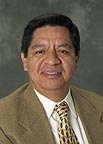December 03, 2007
Researcher to explore water problem in Peru

Caption follows story
An associate professor of civil and environmental engineering at Southern Illinois University Carbondale wants to know why, and he's enlisted the help of the Peruvian government and a large private university there in finding out.
Rolando Bravo, of the College of Engineering at SIUC, recently won approval for his project, which will assemble a baseline of water resource information for the area from scattered sources. He hopes to learn more about water use for agriculture in the areas surrounding the river.
Researchers, led by Bravo, will assess the surface and groundwater components of the area, focusing on collecting and analyzing data in order to make recommendations to local officials and engineers on how to mitigate the water shortage.
"There is now a shortage of water there and we want to know why," Bravo said. "We want to understand what is going on with the ecological cycle there and establish a baseline of research data to begin to understand that."
Bravo, a native of Peru, hopes the baseline information the project provides will also assist the country in obtaining development funds from various sources. The project also will provide an unprecedented opportunity for government agencies and academics to work together on an issue that directly impacts the lives of thousands of residents in the area. It also will give students at the Universidad Alas Peruanas, the private university in Lima, the opportunity to perform actual field research as part of their engineering thesis, and might encourage a number of them to pursue further education at SIUC.
Bravo became interested in the project after learning of the developing water shortage in the area, which lies nears the city of Ica, about 200 miles south of Lima in a region known for its lush beet, asparagus, chick pea and avocado fields. Ica is home to about 200,000 people.
The shortage is a mystery because other than a drought five years ago, things appear to be normal. Water for the area comes from rainfall and the melting of ice caps in the Andes Mountains, which runs into lakes scattered throughout the region. The lakes feed rivers, such as the Ica River.
"The lakes are full, so we don't know if maybe it is raining less or maybe it is raining heavier for shorter periods of time, which is not as productive," Bravo said. "We're trying to make a diagnosis of the problem. Then we can use the results of that to try and get money for a cure."
Bravo began putting the project together several months ago and quickly realized one of the challenges involved included getting various government agencies to talk, share information and work together.
"These agencies make their own studies and have their own objectives but often they don't connect to each other," Bravo said. With help from various individuals, Bravo helped broker a meeting and draft a cooperative agreement among the agencies.
"All the agencies have agreed to cooperate and this is the first time we're seeing the government, the academy and the community sit down together like this and work on a common problem," he said. "Their data needs to be collected, organized and analyzed. We need to study the history and we need to study the future and make predictions."
Bravo made trips to Peru this summer to discuss forming the project and again in November, making some initial surveys and holding meetings. The yearlong project, supported by about $80,000 from Universidad Alas Peruanas, will see him travel back to Peru a half-dozen times or so as he guides its progress.
The researchers will gather data from existing sources, such as rainfall totals, as well as create new data sets, such as an inventory of the estimated 2,500 wells in the area. The team will then analyze the data to try and determine why the river and ground water is drying up.
Despite the difficult circumstances bringing the group together, Bravo is hopeful some good comes out of the situation. For instance, the project will help Universidad Alas Peruanas begin a research initiative, which it currently does not have, Bravo said. Also undergraduate students at Universidad Alas Peruanas are required to complete a thesis and the university does not offer graduate degrees in engineering, Bravo said. He said he is hopeful the project will pique the interest of some students, prompting them to seek further education at SIUC.
"This project will raise our University's profile with those students," Bravo said. Such students might also feel comfortable coming to SIUC knowing the person they worked with on the project — Bravo — is a professor at there.
"Before, the students there really didn't know about us at SIUC," Bravo said. "That has changed."
Officials inaugurated the project Nov. 12 at the Miguel Grau room in the Peruvian Congress. Congress members and distinguished members of the academy, institutes, politicians and entrepreneurs of Peru attended the event, which included a presentation by Bravo about the project.

Caption follows story
Caption:
Water woes – Rolando Bravo, left, associate professor of civil and environmental engineering at Southern Illinois University Carbondale, examines a dry riverbed in Peru with Carlos Blanco, academic coordinator with the Universidad Alas Peruanas, Peru. The two visited the area of in the Rosario del Yauca valley as part of a project Bravo started with that private university, Peruvian government agencies and local communities. The group, led by Bravo, will assemble a baseline of water resource information for the area from scattered sources. They hope to learn more about water use for agriculture in the areas surrounding the river, which is experiencing an unexplained water shortage.
Photo provided
